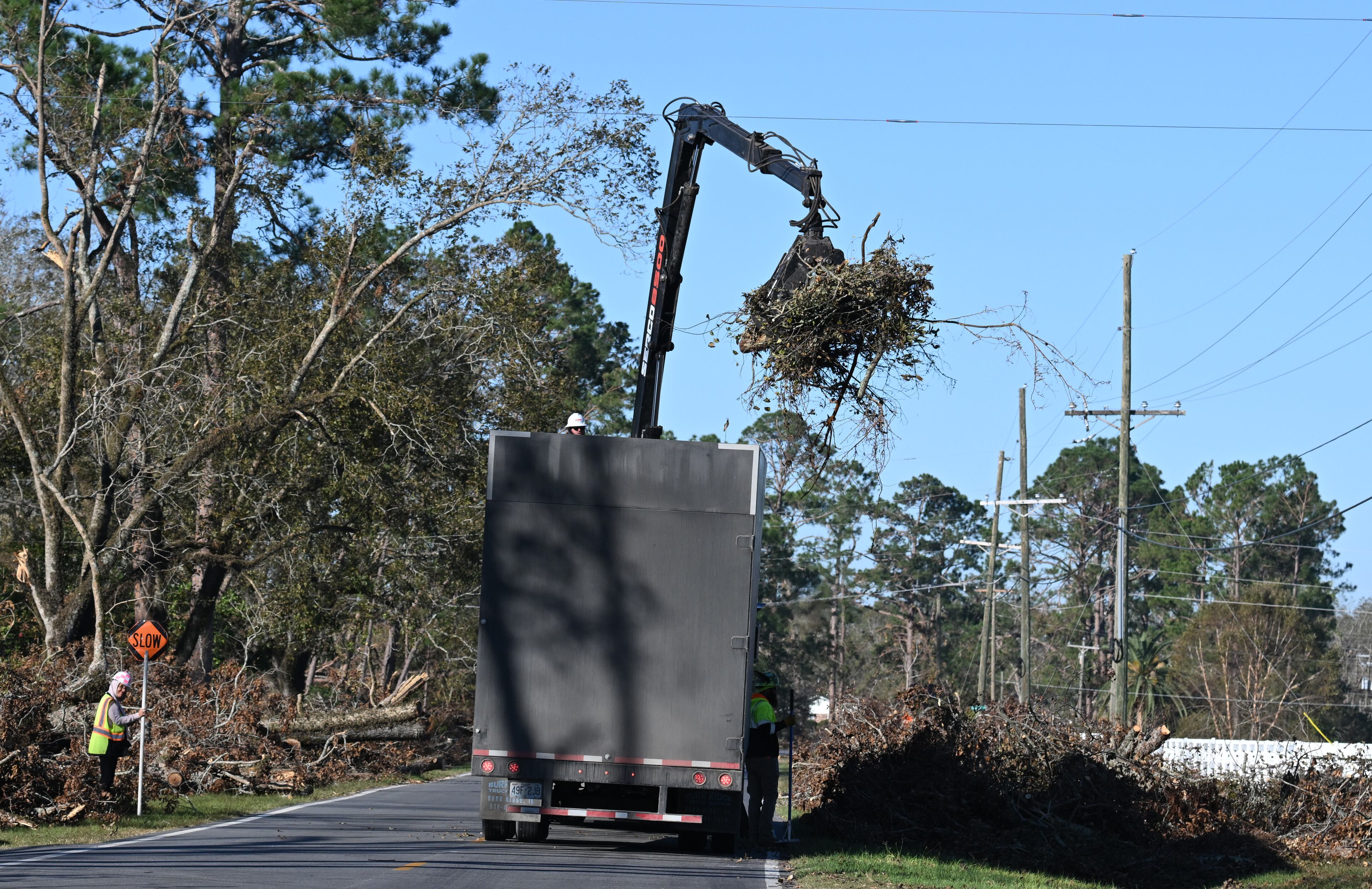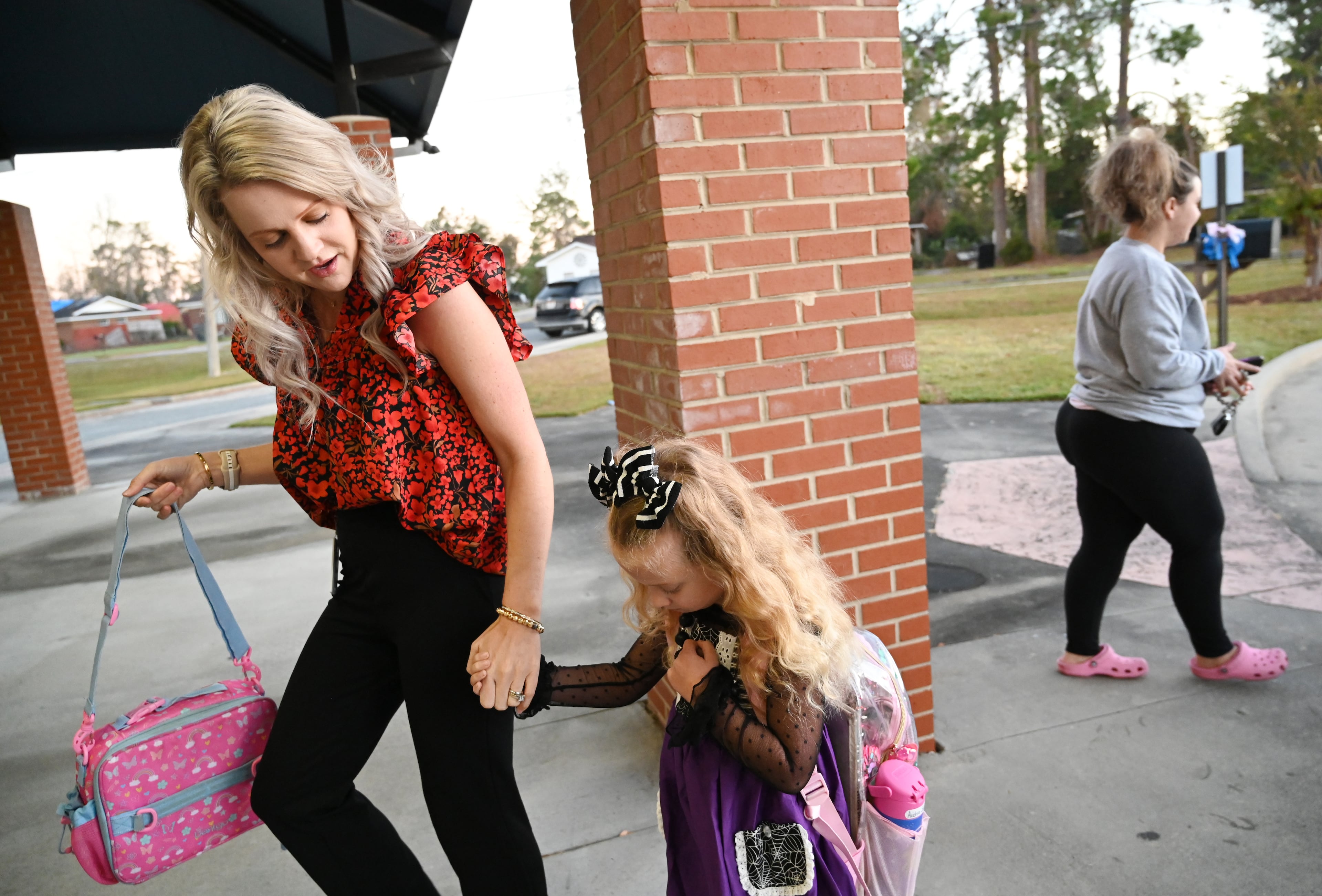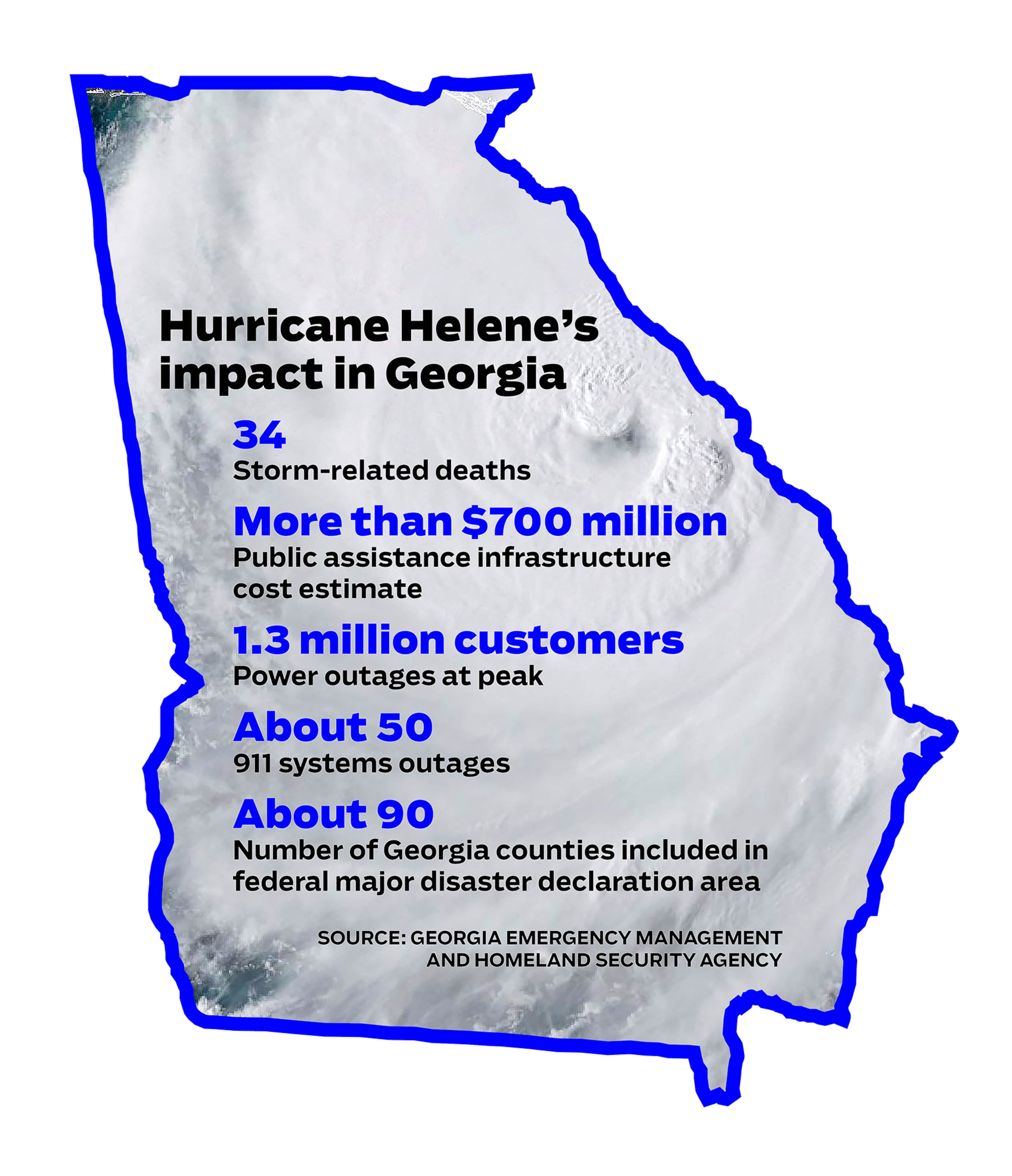A month after Helene, Georgia towns still digging out of destruction

HAZLEHURST — “Good morning, baby. I missed you,” Principal Shelly McBride said, leaning over one of her tiny students. The child murmured something. “Oh, I love you, too,” McBride said.
Her goal was to exude normalcy as she greeted many of the kindergarten through second grade students Monday morning beside the car rider line at Jeff Davis Primary School in this little southeast Georgia city. Teachers held up welcome back signs.
It was the first day of Jeff Davis County schools holding classes since Hurricane Helene thrashed and reshuffled life in many Georgia communities. The last of the county’s schools had only recently regained electricity.
Some kids, with backpacks emblazoned with figures like Sonic or Spidey, were smiling. Others weren’t.

One month after Helene crashed ashore on Florida’s Gulf Coast on Sept. 26 and quickly crossed into Georgia, at times still packing gusts around 100 mph, residents in storm-ravaged areas from Valdosta to Augusta and farther north in the state have seen crucial improvements.
Most have power restored, though for some it only came back on in the last week and a half. The vast majority of roads are passable. Government water systems were back in operation relatively quickly, officials say. They found workarounds to get 911 and first responder communications systems back online.
Fewer distribution events for free water, supplies and food are being held as immediate needs were met. Federal centers have opened to help people fill out forms for disaster aid. Mammoth piles of storm debris have been carted off.
But a mountain of work remains.
Many residents in hardest-hit South Georgia say they are still waiting on insurance adjusters. Internet service is still off in many areas. Cellphone service is often spotty. Some local roofers and tree removal companies are overwhelmed with people seeking help, including in small, rural communities with few contractors.
Roadside debris collection could continue until the new year or spring, some officials think. While some residents expect their roofs to be repaired in weeks, others predict it will be far longer. And some emergency management officials foresee issues that will linger a year and, likely, longer.

In one county, 80% or more of homes damaged
The breadth of the storm was sweeping. Emergency officials say 34 people died in the state. About 90 Georgia counties are included in a major disaster declaration for federal aid. In Jeff Davis County, part of a rural swath from Valdosta to Augusta, possibly 80% to 85% of the homes are damaged, according to the local emergency management agency director.
Neither federal nor Georgia emergency officials have come up with a tally of the storm’s total financial costs or the number of homes damaged or destroyed in the state.
But as far as weather events, “the cost is going to be more than any disaster we have ever had,” predicted Valarie Grooms, the deputy director of recovery for the Georgia Emergency Management and Homeland Security Agency.
The storm is expected to cost more than $700 million just in public assistance in Georgia for needs such as public debris removal from right-of-ways, road repair and reimbursing electric membership corporations to get power service restored, Grooms said. That’s nearly four times more than the public assistance cost for Hurricane Michael, which had been the most expensive storm statewide before Helene, according to Grooms.
Those costs don’t include impacts on individuals, homes, vehicles and many businesses. So far, more than 333,000 people have registered for disaster assistance in Georgia, Federal Emergency Management Agency administrator Deanne Criswell said Wednesday. FEMA has distributed over $159 million in assistance for individuals, but that number will rise, she said.
The economic impact to Georgia agriculture and timber could total $6.46 billion, according to a preliminary estimate by the University of Georgia’s College of Agricultural & Environmental Sciences and the Georgia Forestry Commission.
Behind the sweeping numbers are the lives of people who walked outside the morning of Sept. 27 to damages they couldn’t imagine. Recovery for some has come in slow motion.

Long commutes to work, school by displaced residents
McBride, the principal in Hazlehurst, wasn’t sure how many downed power lines she drove over on her 2-mile ride from home to her school on Monday. Seven people on her staff have homes that are uninhabitable. Trees crushed both of the school resource officer’s cars and two 80-year-old pecan trees came through the roof of his home into a bedroom and the living room.
Damage from Helene left many Georgia families to hunt for weeks for shelter wherever they could: homes of neighbors and family members, some nearby, others hours away. Still others settled in distant hotels, RVs or even sheds and outbuildings. A few stayed in tents on their ravaged property, at least initially, locals said.
On the first day back at school, Autumn Miller rushed in the Jeff Davis Primary School’s door with her 5-year-old son. In normal times, her kindergartner would be considered tardy, but Miller was relieved to learn school officials have temporarily waived such concepts.
She explained that trees crashed down on the family’s home. For weeks, she and her husband, along with their two young kids, have stayed in the closest available hotel they could find — about 70 miles away.
“We are just trying to navigate the new routine,” Miller said.
After kissing her son goodbye, she was headed to her job as a legal assistant. And because the roof is gone on her employer’s local office, she commutes to another town farther away. She said she was told an insurance adjuster won’t be available to check out the family’s home until the second week of November. Then they’ll need to get repair work started, including fixing two water wells busted by trees and clearing their impassable driveway.
She glanced toward where her son walked off down a hallway to class. “He is telling everybody the house is broken.” During the hurricane they had huddled in an uncle’s more sturdy home, but even there a toppled tree smashed out a window. “He has had a hard time moving past the incident.”
Within view of the primary school’s playground, a metal shed sat toppled on its side in a neighbor’s yard like a kid’s discarded Tonka truck.
Surrounding neighborhoods were littered with stumps of trees downed by Helene and then finished off by exhausted residents with chain saws. Still-standing trees, short of leaves and with twisted limbs, looked bedraggled, like much of the community. Many houses remain battered.

Tarps a sign of progress as neighbors, strangers help
Still, some locals said blue tarps stretched over damaged roofs are a sign not so much of destruction but of progress.
Hazlehurst took other steps to push forward. To help students and other local residents, many of whom still don’t have home internet connections, Wi-Fi service was turned on at Jeff Davis High School’s media center and stadium before the school was reopened.
Local officials say electrical systems in parts of South Georgia had to be rebuilt on a bigger scale than they had ever experienced. Fiber optic lines have been among the last of the wires to get reconnected.
Jeff Davis is a poor community. Such a large percentage of the primary school’s students come from lower-income families that all 700 qualify for free breakfast and lunch. Schools Superintendent Chris Roppe worried children in the community would have enough to eat while school was out.
Initially, local officials say, Hazlehurst and other communities were largely on their own for days after the storm. Farmers and loggers began clearing city streets. Local industries offered fuel to keep first responders’ vehicles operating.

People within the community and from other places rushed to help, locals said. Food and supplies were trucked in by organizations such as the American Red Cross and churches from numerous states. Neighbors and strangers used chain saws to free cars and uncover driveways and homes, and strung tarps on rooftops.
“Our community came together like it never had,” said Roppe, adding it didn’t matter whether locals knew the person they were helping or not.
“My prayer is that we don’t lose that,” he said, likening it to how people put out U.S. flags everywhere after 9/11.

Recovery ‘will take time’
Residents in the little city of Uvalda in Montgomery County, north of Hazlehurst, noticed the same feeling. But challenges also remain.
Locally, “nobody was prepared for this,” said retired teacher Cindy Corbitt, who helped the Red Cross.
She cried talking about bringing food to children who were hungry, but still shared with others in their family. “People are suffering and will be for a long time,” particularly those with little money saved up. And she fretted about insects and critters invading damaged homes that people are still attempting to live in.
Montgomery County instituted a curfew initially after the storm as well as a ban on outdoor fires, with first responders struggling to keep up with storm-related responses and so much new kindling littering the ground around homes.
In Jeff Davis County, Charles Wasdin, the fire chief and EMA director, said many homes have relatively minor damage. Missing shingles, a bit of siding shredded off, maybe a broken window. Others have major problems, he said.
“I think we will be made whole again, but with scars,” he said. “And that will take time. It is going to hurt us economically.”

Restoration of power service was a big boost for residents. But with only a few electricians, plumbers and contractors based in Jeff Davis, rebuilding will be slow and difficult, Wasdin said.
Some changes may linger even longer. In various communities in southeast Georgia, people are struck by how different their cities and yards look.
Homeowners with once-wooded lots can now see and hear neighbors. Wasdin notices how Hazlehurst’s skyline has changed, particularly at night or as the sun is going down.
Gady Youmans, a preacher in hard-hit Vidalia, said soon after the storm he turned on his GPS as he drove around because trees that had served as landmarks were gone. But he doesn’t have to leave home to spot damage. From his driveway, he said he can see about six other houses. Two are unlivable, he said. The others have blue tarps on their roofs.

Housing in short supply
In Augusta and Richmond County, about 300 miles from where Helene made landfall in Florida, officials said a significant amount of work remains to recover from a “once in a lifetime storm.” More than 400,000 cubic yards of storm debris had been hauled away from roadsides as of Wednesday. But that’s only about a quarter of what they estimate is out there. Many residents still don’t have home internet service and cellphone reception is spotty. Officials announced a new milestone: All the local traffic lights are now operational.
In Lowndes County, home to Valdosta, and just north of the Florida border, officials counted 149 destroyed homes, another 749 with major damage and 796 with minor damage. Another 46 homes were inaccessible to determine their condition. Among business buildings, 57 sustained major damage and nine were destroyed, said Ashley Tye, the county’s emergency management agency director.
He said he wouldn’t be surprised if two or three years from now, some people are still dealing with some aspect of recovery. Federal disaster aid often won’t cover all financial losses. For people without enough insurance coverage and limited resources, repairs may require getting loans that they could be paying back for more than a decade, he said.

Lynn Moore, the EMA director in Toombs County, which includes Vidalia, roughly halfway between Valdosta and Augusta, said a local FEMA office set up in the wake of the hurricane is still packed every day with people seeking assistance and turning in documents to show their losses.
“I ain’t covered the psychological part of it,” Moore said. “I don’t know how that is going to affect people.”
Some locals worked their whole lives to get what they have, he said. Before the hurricane, “you went to bed Thursday night and had a house and, in a word, you were successful. And then Friday morning you woke up and it was all gone.”
In many areas, housing is already in short supply. In a couple instances, renters said their landlords didn’t want to pay for repairs on aging structures that had been badly damaged. Others face stress being in limbo.
“I’ve had three clients today crying,” said Katie Moore, a real estate agent from Vidalia. “People are running on emotion.”
One of the biggest pain points: insurance or lack of it, she said. Moore also is struggling to help a sister who wants to purchase a house after her own was decimated by the hurricane. But it’s difficult to find one that isn’t already damaged.

Too much or going to be better?
On Dead River Road in Montgomery County, Kathy Hauner said she won’t let herself get used to her new reality. A huge tree busted into a bedroom and a bathroom. It also landed on all three of her vehicles, two of which were destroyed. After five days of cutting the tree, the third vehicle, a pickup truck, is drivable but “she’s crooked,” Hauner said.
Numerous other trees crashed down on her land. Destroyed was the front garden where she had planted roses and other flowering plants as memories of family members who died in years past. Most of the fallen trees remain on the ground, surrounding the battered home once owned by her parents and where she cared for ailing family members.
Hauner said the home wasn’t insured. She estimates that it will take her five years of painstaking work to rid the land of all the fallen debris and the bad reminder it represents.
“I can’t stand it. I can’t stand the mess. Who wants to be looking at it all the time?” she said.
At 64, she wonders about selling the place, concerned she isn’t up for the monumental task of digging out from what Helene wrought.
Maybe, she said, “it’s too much.”
Earlier that day, a county away in Hazlehurst, Laura Ragland had dropped her daughter off at Jeff Davis Primary School. The kindergartner, nervous after weeks away, had cried the night before classes restarted, the mom said.
But, “this morning she woke up and said, ‘I think I’m going to be better, mom.’”

